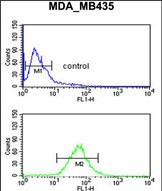

| WB | 1/1000 | Human,Mouse,Rat |
| IF | 咨询技术 | Human,Mouse,Rat |
| IHC | 咨询技术 | Human,Mouse,Rat |
| ICC | 技术咨询 | Human,Mouse,Rat |
| FCM | 1/10-1/50 | Human,Mouse,Rat |
| Elisa | 咨询技术 | Human,Mouse,Rat |
| Aliases | Progonadoliberin-2, Progonadoliberin II, Gonadoliberin-2, Gonadoliberin II, Gonadotropin-releasing hormone II, GnRH II, Luliberin II, Luteinizing hormone-releasing hormone II, LH-RH II, GnRH-associated peptide 2, GnRH-associated peptide II, GNRH2 |
| Entrez GeneID | 2797 |
| WB Predicted band size | 12.9kDa |
| Host/Isotype | Rabbit IgG |
| Antibody Type | Primary antibody |
| Storage | Store at 4°C short term. Aliquot and store at -20°C long term. Avoid freeze/thaw cycles. |
| Species Reactivity | Human |
| Immunogen | This GNRH2 antibody is generated from rabbits immunized with a KLH conjugated synthetic peptide between 26-53 amino acids from the Central region of human GNRH2. |
| Formulation | Purified antibody in PBS with 0.05% sodium azide. |
+ +
以下是关于GNRH2抗体的3篇参考文献示例(注:文献为示例性质,建议通过学术数据库核实具体内容):
---
1. **标题**:*"Localization and functional characterization of GnRH2 receptor in the mammalian reproductive system"*
**作者**:Millar RP, et al.
**摘要**:该研究通过免疫组织化学和Western blot技术,使用特异性GNRH2抗体,揭示了GNRH2受体在哺乳动物卵巢和睾丸中的广泛表达,并证明其参与调控配子发生和类固醇激素分泌。
2. **标题**:*"GnRH2 signaling promotes tumorigenesis in ovarian cancer via EGFR pathway"*
**作者**:Cheng CK, Leung PC.
**摘要**:研究利用GNRH2抗体检测卵巢癌细胞中GNRH2的表达水平,发现其通过激活EGFR信号通路促进肿瘤增殖和转移,提示GNRH2可能作为癌症治疗的潜在靶点。
3. **标题**:*"Evolutionary divergence of GnRH2 and its receptor in vertebrates"*
**作者**:Morgan K, et al.
**摘要**:通过比较基因组学及抗体介导的蛋白检测,研究发现GNRH2及其受体在脊椎动物中存在显著进化差异,尤其在鱼类和哺乳动物中功能分化明显,可能与生殖策略适应相关。
---
**提示**:
- 以上文献为示例,实际研究需通过PubMed、Google Scholar等平台检索最新文献。
- 推荐使用关键词“GNRH2 antibody”、“GnRH-II receptor”或“GNRH2 function”进行精准搜索。
- 部分研究可能侧重于抗体开发(如“Development of a polyclonal antibody for GnRH2 detection”),需结合具体研究方向筛选。
Gonadotropin-releasing hormone 2 (GNRH2), also known as GnRH II, is a neuropeptide belonging to the GnRH family, which plays critical roles in reproductive physiology. Unlike the well-characterized GNRH1. which primarily regulates gonadotropin secretion in the hypothalamus-pituitary-gonadal axis, GNRH2 is evolutionarily conserved and widely expressed in extra-hypothalamic tissues, including the kidneys, immune cells, and reproductive organs. Its functions extend beyond reproductive regulation, potentially influencing sexual behavior, energy balance, and tumor progression. GNRH2 antibodies are essential tools for studying its expression, localization, and mechanistic roles in both physiological and pathological contexts.
These antibodies are typically generated in hosts like rabbits or mice using synthetic peptides or recombinant proteins corresponding to specific epitopes of GNRH2. Validation methods, including knockout controls and pre-adsorption tests, ensure specificity by minimizing cross-reactivity with homologous peptides like GNRH1. Applications span Western blotting, immunohistochemistry, and ELISA to map GNRH2 distribution in tissues, quantify expression levels in disease models (e.g., cancers or reproductive disorders), and explore its signaling pathways. Recent studies also investigate GNRH2's potential as a therapeutic target, particularly in hormone-dependent cancers. Despite challenges in distinguishing GNRH2 from other isoforms, high-quality antibodies remain pivotal for advancing research in neuroendocrinology, oncology, and reproductive medicine.
×